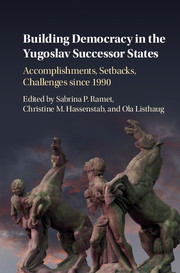 Building Democracy in the Yugoslav Successor States
Building Democracy in the Yugoslav Successor States Book contents
- Frontmatter
- Dedication
- Contents
- List of Boxes
- List of Figures
- List of Tables
- Notes on Editors
- Notes on Contributors
- Preface
- Part I Introduction and Theory
- 1 The Challenge of Democratization: An Introduction
- 2 Post-Yugoslav Patterns of Democratization
- 3 The Importance of Tolerance: Intolerance and Its Consequences in the Yugoslav Successor States
- 4 Institutional Trust in the Yugoslav Successor States: A Comparative Approach
- 5 Political Culture in the Yugoslav Successor States
- 6 The Impact of the ICTY on Democratization in the Yugoslav Successor States
- Part II Country Studies
- Part III Conclusion
- Further Reading
- Index
2 - Post-Yugoslav Patterns of Democratization
from Part I - Introduction and Theory
Published online by Cambridge University Press: 25 May 2017
- Frontmatter
- Dedication
- Contents
- List of Boxes
- List of Figures
- List of Tables
- Notes on Editors
- Notes on Contributors
- Preface
- Part I Introduction and Theory
- 1 The Challenge of Democratization: An Introduction
- 2 Post-Yugoslav Patterns of Democratization
- 3 The Importance of Tolerance: Intolerance and Its Consequences in the Yugoslav Successor States
- 4 Institutional Trust in the Yugoslav Successor States: A Comparative Approach
- 5 Political Culture in the Yugoslav Successor States
- 6 The Impact of the ICTY on Democratization in the Yugoslav Successor States
- Part II Country Studies
- Part III Conclusion
- Further Reading
- Index
Summary
After more than twenty-five years since the beginning of the transition from authoritarian single-party rule to multi-party politics, there is no doubt that the countries that have emerged from Yugoslavia are democracies. During the years 1989 to 1991, however, this eventual outcome was by no means certain. At that time, the future of democracy in Central and Southeastern Europe was unclear and the countries in the Southeastern tier lagged behind those in Central Europe. Bulgaria and Romania saw a change of leadership in November and December 1989, the former through a palace coup, the latter through a combination of a violent revolution and a coup. Yugoslavia and Albania did not experience any such changes during that year and seemed at first isolated from developments elsewhere. In the absence of Soviet dominance, the combination of the call for democracy and against Soviet influence was less salient and the homegrown legacy of communism appeared to set them apart. However, the communist parties in both countries soon had to agree to allow multi-party elections in 1990 and 1991. If the striking feature of 1989 was the remarkable speed and certainty with which democracy emerged as the sole acceptable political system in Central Europe, doubts lingered in Albania, Bulgaria, and Romania, as well as most Yugoslav republics. Either socialist incumbents, only partially reformed, displayed strong authoritarian traits or new parties often with nationalist ideologies took office with little interest in transforming the states into liberal polities. It would take another move toward democracy through a combination of the ballot box and popular protest movements to shift the countries more decisively toward democracy. However, as this chapter argues, enduring legacies of both communist and post-communist governments have restrained the countries’ consolidation as liberal democracies. While there is a distinct North–South pattern of democratic consolidation, with Slovenia moving quickly toward liberal democracy and Croatia struggling with authoritarianism for a decade before a decisive move toward democracy in 2000, the other post-Yugoslav republics have been struggling with moving toward liberal democracy for different reasons, such as contested statehood (“stateness”) in Bosnia-Herzegovina and Kosovo to state capture in Montenegro and authoritarian patterns in Serbia and Macedonia.
- Type
- Chapter
- Information
- Building Democracy in the Yugoslav Successor StatesAccomplishments, Setbacks, and Challenges since 1990, pp. 38 - 57Publisher: Cambridge University PressPrint publication year: 2017
- 2
- Cited by


